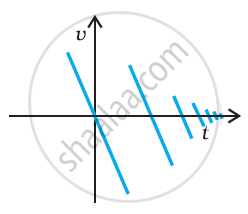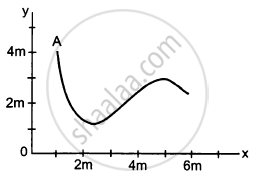Advertisements
Advertisements
Question
A particle executes the motion described by x(t) = x0(1 − e −γt); t ≥ 0, x0 > 0. Find maximum and minimum values of x(t), v(t), a(t). Show that x(t) and a(t) increase with time and v(t) decreases with time.
Solution
Given, `x(t) = x_0 (1 - e^(-γt))`
`v(t) = (dx(t))/(dt) = x_0 γe^(-γt)`
`a(t) = (dv(t))/(dt) = - x_0 γ^2 e^(-γt)`
x(t) is maximum when t = ∞ [x(t)]max = x0
x(t) is minimum when t = 0 [x(t)]min = 0
v(t) is maximum when t = 0; v(0) = x0γ
v(t) is minimum when t = ∞; v(∞) = 0
a(t) is maximum when t = ∞; a(∞) = 0
a(t) is minimum when t = 0; a(∞) = − x0γ2
APPEARS IN
RELATED QUESTIONS
A jet airplane travelling at the speed of 500 km h–1 ejects its products of combustion at the speed of 1500 km h–1 relative to the jet plane. What is the speed of the latter with respect to an observer on ground?
Read the statement below carefully and state, with reason and example, if it is true or false:
A particle in one-dimensional motion with zero speed may have non-zero velocity.
Suggest a suitable physical situation for the following graph:

Figure A particle starts from a point A and travels along the solid curve shown in the following figure. Find approximately the position B of the particle such that the average velocity between the position A and B has the same direction as the instantaneous velocity at B.

Write the SI units of speed and average speed.
Two cars are moving with speeds of 40 km/hr due North and 40 km/hr due South respectively. Do they have the same velocity?
In one dimensional motion, instantaneous speed v satisfies 0 ≤ v < v0.
The displacement of a particle is given by x = (t – 2)2 where x is in metres and t in seconds. The distance covered by the particle in first 4 seconds is ______.
A particle executes the motion described by x(t) = x0 (1 − e − γt); t ≥ 0, x0 > 0. Where does the particle start and with what velocity?
A monkey climbs up a slippery pole for 3 seconds and subsequently slips for 3 seconds. Its velocity at time t is given by v(t) = 2t (3 – t); 0 < t < 3 and v(t) = – (t – 3)(6 – t) for 3 < t < 6 s in m/s. It repeats this cycle till it reaches the height of 20 m.
- At what time is its velocity maximum?
- At what time is its average velocity maximum?
- At what time is its acceleration maximum in magnitude?
- How many cycles (counting fractions) are required to reach the top?
